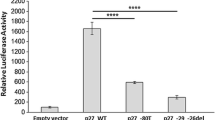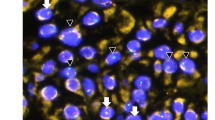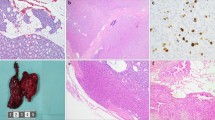Abstract
The tumor suppressor adenomatous polyposis coli (APC) has recently been implicated in parathyroid development. We here report clinical, histopathological and molecular investigations in parathyroid tumors arising in two patients; one familial adenomatous polyposis (FAP) syndrome patient carrying a constitutional APC mutation, and one Lynch syndrome patient demonstrating a germline MLH1 mutation as well as a non-classified, missense alteration of the APC gene. We sequenced the entire APC gene in tumor and constitutional DNA from both cases, assessed the levels of APC promoter 1A and 1B methylation by bisulfite Pyrosequencing analysis and performed immunohistochemistry for APC and parafibromin. In addition, copy number analysis regarding the APC gene on chromosome 5q21-22 was performed using qRT-PCR. Histopathological workup confirmed both tumors as parathyroid adenomas without signs of malignancy or atypia. No somatic mutations or copy number changes for the APC gene were discovered in the tumors; however, in both cases, the APC promoter 1A was hypermethylated while the APC promoter 1B was unmethylated. APC promoter 1B-specific mRNA and total APC mRNA levels were higher than in normal parathyroid samples. Immunohistochemical analyses revealed strong APC protein immunoreactivity and positive parafibromin expression in both parathyroid tumors. Absence of additional somatic APC mutations and copy number changes in addition to the positive APC immunoreactivity obtained suggest that the tumors arose without biallelic inactivation of the APC tumor suppressor gene. The finding of an unmethylated APC promoter 1B and high APC 1B mRNA levels could explain the maintained APC protein expression. Moreover, the findings of positive parafibromin and APC immunoreactivity as well as a low MIB-1 proliferation index and absence of histopathological features of malignancy/atypical adenoma indicate that the parathyroid adenomas arising in these patients did not harbor malignant potential.

Similar content being viewed by others
References
DeLellis RA, Lloyd RV et al (2004) Pathology and genetics of the tumours of endocrine organs, WHO classification of tumours. IARC Press, Lyon
DeLellis RA, Mazzaglia P, Mangray S (2008) Primary hyperparathyroidism: a current perspective. Arch Pathol Lab Med 132:1251–1262
Carpten JD, Robbins CM, Villablanca A, Forsberg L, Presciuttini S, Bailey-Wilson J, Simonds WF, Gillanders EM, Kennedy AM, Chen JD, Agarwal SK, Sood R, Jones MP, Moses TY, Haven C, Petillo D, Leotlela PD, Harding B, Cameron D, Pannett AA, Höög A, Heath H III, James-Newton LA, Robinson B, Zarbo RJ, Cavaco BM, Wassif W, Perrier ND, Rosen IB, Kristoffersson U, Turnpenny PD, Farnebo LO, Besser GM, Jackson CE, Morreau H, Trent JM, Thakker RV, Marx SJ, Teh BT, Larsson C, Hobbs MR (2002) HRPT2, encoding parafibromin, is mutated in hyperparathyroidism-jaw tumor syndrome. Nat Genet 32:676–680
Mosimann C, Hausmann G, Basler K (2006) Parafibromin/Hyrax activates Wnt/Wg target gene transcription by direct association with beta-catenin/Armadillo. Cell 125:327–341
Juhlin CC, Haglund F, Villablanca A, Forsberg L, Sandelin K, Bränström R, Larsson C, Höög A (2009) Loss of expression for the Wnt pathway components adenomatous polyposis coli and glycogen synthase kinase 3-beta in parathyroid carcinomas. Int J Oncol 34:481–492
Juhlin CC, Nilsson IL, Johansson K, Haglund F, Villablanca A, Höög A, Larsson C (2010) Parafibromin and APC as screening markers for malignant potential in atypical parathyroid adenomas. Endocr Pathol 21:166–177
Svedlund J, Aurén M, Sundström M, Dralle H, Akerström G, Björklund P, Westin G (2010) Aberrant WNT/β-catenin signaling in parathyroid carcinoma. Mol Cancer 9:294
Juhlin CC, Kiss NB, Villablanca A, Haglund F, Nordenström J, Höög A, Larsson C (2010) Frequent promoter hypermethylation of the APC and RASSF1A tumour suppressors in parathyroid tumours. PLoS ONE 5:e9472
Segditsas S, Sieber OM, Rowan A, Setien F, Neale K, Phillips RK, Ward R, Esteller M, Tomlinson IP (2008) Promoter hypermethylation leads to decreased APC mRNA expression in familial polyposis and sporadic colorectal tumours, but does not substitute for truncating mutations. Exp Mol Pathol 285:201–206
Hosoya K, Yamashita S, Ando T, Nakajima T, Itoh F, Ushijima T (2009) Adenomatous polyposis coli 1A is likely to be methylated as a passenger in human gastric carcinogenesis. Cancer Lett 285:182–189
Rohlin A, Engwall Y, Fritzell K, Göransson K, Bergsten A, Einbeigi Z, Nilbert M, Karlsson P, Björk J, Nordling M (2011) Inactivation of promoter 1B of APC causes partial gene silencing: evidence for a significant role of the promoter in regulation and causative of familial adenomatous polyposis. Oncogene (Epub ahead of print)
Worm J, Christensen C, Grønbaek K, Tulchinsky E, Guldberg P (2004) Genetic and epigenetic alterations of the APC gene in malignant melanoma. Oncogene 23:5215–5226
Nishisho I, Nakamura Y, Miyoshi Y, Miki Y, Ando H, Horii A, Koyama K, Utsunomiya J, Baba S, Hedge P (1991) Mutations of chromosome 5q21 genes in FAP and colorectal cancer patients. Science 253:665–669
Rubinfeld B, Souza B, Albert I, Müller O, Chamberlain SH, Masiarz FR, Munemitsu S, Polakis P (1993) Association of the APC gene product with beta-catenin. Science 262:1731–1734
Goss KH, Groden J (2000) Biology of the adenomatous polyposis coli tumor suppressor. J Clin Oncol 18:1967–1979
Nilsson IL, Zedenius J, Li Y, Ekbom A (2007) The association between primary hyperparathyroidism and malignancy. Nationwide cohort analysis on cancer incidence after parathyroidectomy. Endocr Relat Cancer 14:1–7
Sakai Y, Koizumi K, Sugitani I, Nakagawa K, Arai M, Utsunomiya J, Muto T, Fujita R, Kato Y (2002) Familial adenomatous polyposis associated with multiple endocrine neoplasia type 1-related tumors and thyroid carcinoma: a case report with clinicopathologic and molecular analyses. Am J Surg Pathol 26:103–110
Sener SF, Miller HH, DeCosse JJ (1984) The spectrum of polyposis. Surg Gynecol Obstet 159:525–532
Haglund F, Andreasson A, Nilsson IL, Höög A, Larsson C, Juhlin CC (2010) Lack of S37A CTNNB1/β-catenin mutations in a Swedish cohort of 98 parathyroid adenomas. Clin Endocrinol (Oxf) 73:552–553
Miyoshi Y, Ando H, Nagase H, Nishisho I, Horii A, Miki Y, Mori T, Utsunomiya J, Baba S, Petersen G et al (1992) Germ-line mutations of the APC gene in 53 familial adenomatous polyposis patients. Proc Natl Acad Sci USA 89:4452–4456
Tominaga Y, Takagi H (1996) Molecular genetics of hyperparathyroid disease. Curr Opin Nephrol Hypertens 5:336–341
Acknowledgments
The authors are truly obliged to the expert help provided by Prof. Lars Grimelius of Karolinska University Hospital Solna and Uppsala University Hospital for carefully reviewing the parathyroid tumors by light microscopy. Furthermore, the authors are indebted to Ms. Elisabet Ånfalk for careful tissue management and the Medical Genetics group for valuable discussions.
Conflict of interest
The authors declare that they have no conflict of interest.
Author information
Authors and Affiliations
Corresponding author
Electronic supplementary material
Below is the link to the electronic supplementary material.
10689_2012_9520_MOESM1_ESM.ppt
Photomicrographs (×20) of the parathyroid tumor from Case 2 showing positive nuclear expression of MLH1 and PMS2 respectively. Lymphocytes and fibroblasts were assessed as internal negative controls. Inserts in the lower left corners were taken using a ×60 objective. (PPT 1689 kb)
Rights and permissions
About this article
Cite this article
Andreasson, A., Sulaiman, L., do Vale, S. et al. Molecular characterization of parathyroid tumors from two patients with hereditary colorectal cancer syndromes. Familial Cancer 11, 355–362 (2012). https://doi.org/10.1007/s10689-012-9520-z
Published:
Issue Date:
DOI: https://doi.org/10.1007/s10689-012-9520-z




